Analys
The EUA price could drop to EUR 40/ton and then be picked up by Airliners, Shipping and Utilities

The EUA price is dropping hard along with a sharp decline in the front-year TTF nat gas contract. The typical last-round sell-off in EUA prices have typically been a final sell-off of 10-20-30%. From EUR 60/ton level it implies a price decline down to EUR 54; 48; 42/ton. The front-year nat gas price and the front-year Coal-to-Gas (C-t-G) differential is what has held the EUA price above EUR 60/ton. But if the TTF 2025 price falls down to EUR 27/ton the front-year C-t-G differential will fall all the way towards EUR 40/ton. That TTF 2025 falls to EUR 27/ton or lower seems likely to happen and the risk is high that the EUA price will be sucked down along with it. But nat gas demand is starting to come back with a lag in nat gas price declines in the EU but probably also in Asia. Thus first an over-sell in nat gas prices, then demand revival and then a rebound in both nat gas prices and EUA prices. Airliners, shipping companies and Utilities will probably buy as much EUAs they can get if the EUA price fall down towards EUR 40/ton.
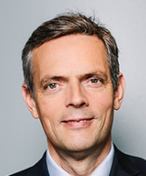
Front-year 2025 TTF nat gas price falls hard and so does the EUA price. The front-month EUA price dropped 2.7% yesterday to EUR 58.97/ton and thus broke out of the sideways trend around EUR 61/ton since 18 January. Today it has sold off another 3.2% to EUR 57.1/ton.
Again it is the nat gas price which is leading the way and more specifically it is about the front-year nat gas which lost 1.9% on Wednesday and another 2.5% again ydy to a close of EUR 30.65/MWh and today it has solf off 2.8% to EUR 29.8/ton.
The EUA price has very clearly been balancing on the front-year Coal-to-Gas (C-t-G) differentials. The C-t-G differentials have been significantly lower than EUR 60/ton both at the front-end of the curve (1-2-3 month) and for calendars 2026 and 2027. But the front-year nat gas price has held up at around EUR 31/MWh quite well since around mid January.
How far down will the EUA price go? The final sell-off could be down towards EUR 40/ton. With these dynamics the big question then becomes: How far down will the front-year nat gas contract sell? It will of course sell off too far as commodities always do. The reason commodities do this is the natural reactive chain of events which normally comes with a lag: First the price goes down before dropping hard in the final round of the sell-off. Then demand comes back with a lag to the price action. This again drives the price back up and off from the lows to a level consistent with the revival in demand. If demand instead had reacted immediately to lower prices then the hard drop at the end of the sell-off might not have happened.
Looking at previous hard, final sell-off-drops in the EUA price we can see that final drops typically have been 10-20-30% as the last final drop. If we take the EUR 60/ton as the starting point of this final drop, then we are talking an EUA price bottom of somewhere in the range of EUR 54; 48; 42/ton.
Global nat gas demand destruction in the face of very high nat gas prices solved the energy crisis. Let’s link this back to price action in nat gas. The reason why Europe has managed the recent energy crisis (Russia/Ukraine, nat gas,…) so surprisingly well is 1) Large reduction in nat gas demand in EU due to exceptionally high prices and 2) Significant demand destruction in Asia freeing up nat gas to flow to the EU. I.e. it was global demand destruction of nat gas in response to extremely high prices globally which solved the energy crisis. It was solved by the global market.
Demand for nat gas is starting to come back as the price falls. The nominal historical average nat gas TTF price was EUR 20/MWh from 2010 to 2019. But the real average was EUR 26/MWh. So seen from the eyes of consumers in both Europe and Asia, a price of EUR 26/MWh is an historically absolutely normal price. Demand for nat gas should thus naturally accelerate back towards normal levels at current nat gas prices. Not just in Europe, but also globally in all regions exposed to nat gas prices set by global LNG prices. This is already happening in the EU. Temp. adj. demand destruction vs. normal has typically been running at around 16% from mid-2022 to December 2023. Average ytd is 14% while the last 15 days is 9%. Demand destruction is fading as the price of nat gas is falling. But do remember that this is also happening in Asia but it is harder to track.
Normal nat gas demand AND normal gas prices is not consistent as Russian nat gas exports still down 1100 TWh/yr. There is however an inconsistency here in expecting normal prices and normal demand for natural gas now onward. The inconsistency is that the EU and thus the world is still robbed of the normal flow of nat gas on pipelines to Europe. This amounts to a loss of 3 TWh/day and thus close to 1100 TWh/year. When this gas is no longer flowing to the EU it isn’t flowing anywhere. It is lost to both the EU and the world. Until that is, Russia has built loads of new pipes to Asia and new LNG terminals. And that takes years.
A return to normal prices and normal demand while the world still is missing 1100 TWh/year of Russian nat gas isn’t really a consistent outcome in our view.
Demand for nat gas will continue to revive as the price of nat gas keeps falling. But both the EU and the world still need of a nat gas price at above normal levels to induce a certain amount of demand destruction until the point in time when new LNG export facilities globally has managed to replace the 1100 TWh/year we have lost from Russia.
Front-end TTF nat gas down to EUR 27/MWh could drive the EUA price to EUR 40/ton. The dynamic sell-off nat gas, prices will likely move lower than to the level which over time is consistent with continued need for some demand destruction globally. This because demand revival will come with a lag to the decline in prices. It is thus fully plausible that the TTF 2025 contract moves all the way down to EUR 27/MWh (or maybe even lower). If so it would imply a 2025 C-t-G differential of only EUR 40/ton for the EUA price to balance on and reference to. That could be the final hard drop in the EUA price. That’s a 30% drop from EUR 60/ton. But it won’t last because that nat gas price is likely too low vs. what is needed globally to maintain some level of demand destruction for a while longer.
An EUA price of EUR 40/ton would also be too cheap to resist for a range of market participants and they’d likely jump in and purchase with both hands. Airliners and shipping companies which will have difficulties of shifting away from fossil fuels and will need EUAs for years to come. Also utilities could step in and purchase large amounts of EUAs even if forward margins are negative. Some EU based utilities with large fossil-based assets bought truckloads of EUAs from 2011 to 2017 when the EUA price ranged from EUR 3/ton to EUR 9/ton. For them the EUA certificate is not only a marginal cost. It is also a licence to operate. The EUA price will of course not return to that level again. But if we move to EUR 40-50/ton, then it will probably trigger strategic buying by shipping companies, airliners as well as utilities.
Front-year TTF nat gas TTF price is dropping and leading the EUA price lower after a period of sideways action since mid-Jan
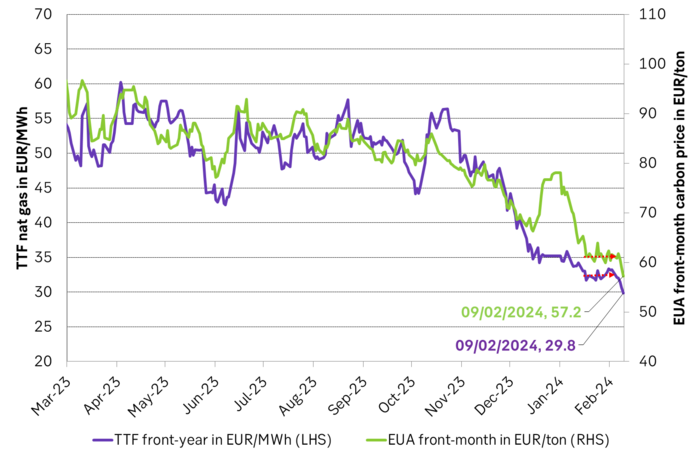
But the EU and the world is still missing some 3 TWh/d or 1100 TWh/yr of piped nat gas from Russia. When Russian nat gas is no longer flowing on pipes to Europe, it is flowing nowhere.
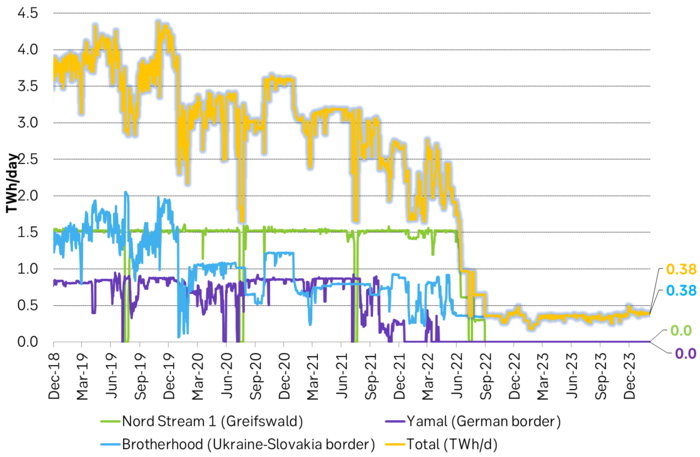
Nat gas demand destruction in the EU has been running at 15% to 17% since mid-2022 in the face of high nat gas prices. But demand destruction is now fading down to 8%. Demand has started to come back as nat gas prices fall. Demand is probably also coming back in Asia, but not so easily to see.
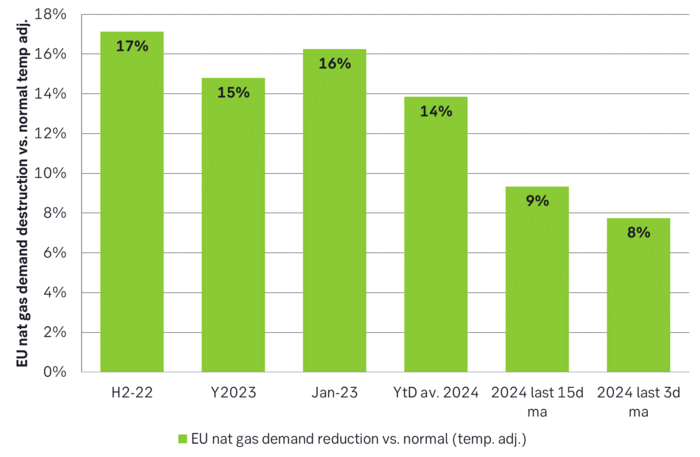
EU nat gas demand destruction has started to fade.
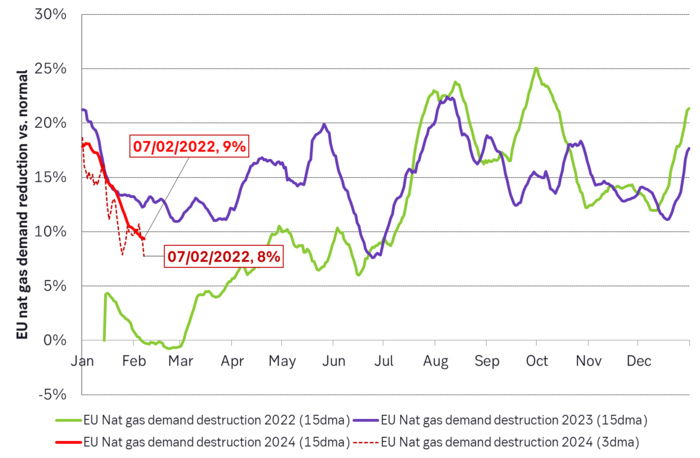
Forward Coal to Gas (C-t-G) differentials vs EUA market prices. The EUA price has balanced on the front-year differential. But that has now fallen like a rock along with the fall in front-year TTF nat gas price. Lead the EUA into a free-fall
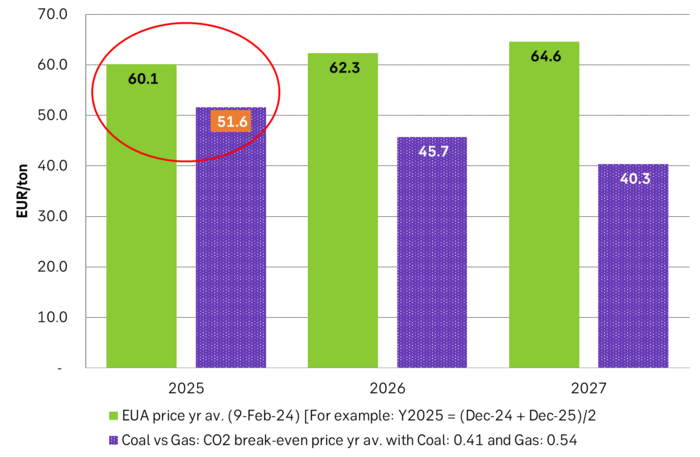
The front-year Coal-to-Gas differential is a distribution of crosses between many different levels of efficiencies for coal and nat gas power plants. Averages of these are EUR 52.4/ton with Coal at USD 94.3/ton and Nat gas at EUR 29.8/MWh (both front-year 2025 prices). So EUA price is still hanging high.

Analys
Sell the rally. Trump has become predictable in his unpredictability

Hesitant today. Brent jumped to an intraday high of $66.36/b yesterday after having touched an intraday low of $60.07/b on Monday as Indian and Chinese buyers cancelled some Russian oil purchases and instead redirected their purchases towards the Middle East due to the news US sanctions. Brent is falling back 0.4% this morning to $65.8/b.

It’s our strong view that the only sensible thing is to sell this rally. In all Trump’s unpredictability he has become increasingly predictable. Again and again he has rumbled about how he is going to be tough on Putin. Punish Putin if he won’t agree to peace in Ukraine. Recent rumbling was about the Tomahawk rockets which Trump threatened on 10 October and 12 October to sell/send to Ukraine. Then on 17 October he said that ”the U.S. didn’t want to give away weapons (Tomahawks) it needs”.
All of Trump’s threats towards Putin have been hot air. So far Trump’s threats have been all hot air and threats which later have evaporated after ”great talks with Putin”. After all these repetitions it is very hard to believe that this time will be any different. The new sanctions won’t take effect before 21. November. Trump has already said that: ”he was hoping that these new sanctions would be very short-lived in any case”. Come 21. November these new sanctions will either evaporate like all the other threats Trump has thrown at Putin before fading them. Or the sanctions will be postponed by another 4 weeks or 8 weeks with the appearance that Trump is even more angry with Putin. But so far Trump has done nothing that hurt Putin/Russia. We can’t imagine that this will be different. The only way forward in our view for a propre lasting peace in Ukraine is to turn Ukraine into defensive porcupine equipped with a stinging tail if need be.
China will likely stand up to Trump if new sanctions really materialize on 21 Nov. Just one country has really stood up to Trump in his tariff trade war this year: China. China has come of age and strength. I will no longer be bullied. Trump upped tariffs. China responded in kind. Trump cut China off from high-end computer chips. China put on the breaks on rare earth metals. China won’t be bullied any more and it has the power to stand up. Some Chinese state-owned companies like Sinopec have cancelled some of their Russian purchases. But China’s Foreign Ministry spokesperson Guo Jiakun has stated that China “oppose unilateral sanctions which lack a basis in international law and authorization of the UN Security Council”. Thus no one, not even the US shall unilaterally dictate China from whom they can buy oil or not. This is yet another opportunity for China to show its new strength and stand up to Trump in a show of force. Exactly how China choses to play this remains to be seen. But China won’t be bullied by over something as important as its oil purchases. So best guess here is that China will defy Trump on this. But probably China won’t need to make a bid deal over this. Firstly because these new sanctions will either evaporate as all the other threats or be postponed once we get to 21 November. Secondly because the sanctions are explicit towards US persons and companies but only ”may” be enforced versus non-US entities.
Sanctions is not a reduction in global supply of oil. Just some added layer of friction. Anyhow, the new sanctions won’t reduce the supply of Russian crude oil to the market. It will only increase the friction in the market with yet more need for the shadow fleet and ship to ship transfer of Russian oil to dodge the sanctions. If they materialize at all.
The jump in crude oil prices is probably due to redirections of crude purchases to the Mid-East and not because all speculators are now turned bullish. Has oil rallied because all speculators now suddenly have turned bullish? We don’t think so. Brent crude has probably jumped because some Indian and Chinese oil purchasers of have redirected their purchases from Russia towards the Mid-East just in case the sanctions really materializes on 21 November.
Analys
Brent crude set to dip its feet into the high $50ies/b this week

Parts of the Brent crude curve dipping into the high $50ies/b. Brent crude fell 2.3% over the week to Friday. It closed the week at $61.29/b, a slight gain on the day, but also traded to a low of $60.14/b that same day and just barely avoided trading into the $50ies/b. This morning it is risk-on in equities which seems to help industrial metals a little higher. But no such luck for oil. It is down 0.8% at $60.8/b. This week looks set for Brent crude to dip its feet in the $50ies/b. The Brent 3mth contract actually traded into the high $50ies/b on Friday.

The front-end backwardation has been on a weakening foot and is now about to fully disappear. The lowest point of the crude oil curve has also moved steadily lower and lower and its discount to the 5yr contract is now $6.8/b. A solid contango. The Brent 3mth contract did actually dip into the $50ies/b intraday on Friday when it traded to a low point of $59.93/b.
More weakness to come as lots of oil at sea comes to ports. Mid-East OPEC countries have boosted exports along with lower post summer consumption and higher production. The result is highly visibly in oil at sea which increased by 17 mb to 1,311 mb over the week to Sunday. Up 185 mb since mid-August. On its way to discharge at a port somewhere over the coming month or two.
Don’t forget that the oil market path ahead is all down to OPEC+. Remember that what is playing out in the oil market now is all by design by OPEC+. The group has decided that the unwind of the voluntary cuts is what it wants to do. In a combination of meeting demand from consumers as well as taking back market share. But we need to remember that how this plays out going forward is all at the mercy of what OPEC+ decides to do. It will halt the unwinding at some point. It will revert to cuts instead of unwind at some point.
A few months with Brent at $55/b and 40-50 US shale oil rigs kicked out may be what is needed. We think OPEC+ needs to see the exit of another 40-50 drilling rigs in the US shale oil patches to set US shale oil production on a path to of a 1 mb/d year on year decline Dec-25 to Dec-26. We are not there yet. But a 2-3 months period with Brent crude averaging $55/b would probably do it.
Oil on water increased 17 mb over the week to Sunday while oil in transit increased by 23 mb. So less oil was standing still. More was moving.

Crude oil floating storage (stationary more than 7 days). Down 11 mb over week to Sunday

The lowest point of the Brent crude oil curve versus the 5yr contract. Weakest so far this year.

Crude oil 1mth to 3mth time-spreads. Dubai held out strongly through summer, but then that center of strength fell apart in late September and has been leading weakness in crude curves lower since then.

Analys
Crude oil soon coming to a port near you

Rebounding along with most markets. But concerns over solidity of Gaza peace may also contribute. Brent crude fell 0.8% yesterday to $61.91/b and its lowest close since May this year. This morning it is bouncing up 0.9% to $62.5/b along with a softer USD amid positive sentiment with both equities and industrial metals moving higher. Concerns that the peace in Gaza may be less solid than what one might hope for also yields some support to Brent. Bets on tech stocks are rebounding, defying fears of trade war. Money moving back into markets. Gold continues upwards its strong trend and a softer dollar helps it higher today as well.

US crude & products probably rose 5.6 mb last week (API) versus a normal seasonal decline of 2.4 mb. The US API last night partial and thus indicative data for US oil inventories. Their data indicates that US crude stocks rose 7.4 mb last week, gasoline stocks rose 3.0 mb while Distillate stocks fell 4.8 mb. Altogether an increase in commercial crude and product stocks of 5.6 mb. Commercial US crude and product stocks normally decline by 2.4 mb this time of year. So seasonally adjusted the US inventories rose 8 mb last week according to the indicative numbers by the API. That is a lot. Also, the counter seasonal trend of rising stocks versus normally declining stocks this time of year looks on a solid pace of continuation. If the API is correct then total US crude and product stocks would stand 41 mb higher than one year ago and 6 mb higher than the 2015-19 average. And if we combine this with our knowledge of a sharp increase in production and exports by OPEC(+) and a large increase in oil at sea, then the current trend in US oil inventories looks set to continue. So higher stocks and lower crude oil prices until OPEC(+) switch to cuts. Actual US oil inventory data today at 18:00 CET.
US commercial crude and product stocks rising to 1293 mb in week 41 if last nights indicative numbers from API are correct.

Crude oil soon coming to a port near you. OPEC has lifted production sharply higher this autumn. At the same time demand for oil in the Middle-East has fallen as we have moved out of summer heat and crude oil burn for power for air-conditioning. The Middle-East oil producers have thus been able to lift exports higher on both accounts. Crude oil and condensates on water has shot up by 177 mb since mid-August. This oil is now on its way to ports around the world. And when they arrive, it will likely help to lift stocks onshore higher. That is probably when we will lose the last bit of front-end backwardation the the crude oil curves. That will help to drive the front-month Brent crude oil price down to the $60/b line and revisit the high $50ies/b. Then the eyes will be all back on OPEC+ when they meet in early November and then again in early December.
Crude oil and condensates at sea have moved straight up by 177 mb since mid-August as OPEC(+) has produced more, consumed less and exported more.

-

 Nyheter4 veckor sedan
Nyheter4 veckor sedanOPEC+ missar produktionsmål, stöder oljepriserna
-

 Nyheter3 veckor sedan
Nyheter3 veckor sedanGoldman Sachs höjer prognosen för guld, tror priset når 4900 USD
-

 Nyheter3 veckor sedan
Nyheter3 veckor sedanBlykalla och amerikanska Oklo inleder ett samarbete
-

 Nyheter3 veckor sedan
Nyheter3 veckor sedanGuld nära 4000 USD och silver 50 USD, därför kan de fortsätta stiga
-

 Nyheter2 veckor sedan
Nyheter2 veckor sedanLeading Edge Materials är på rätt plats i rätt tid
-

 Nyheter3 veckor sedan
Nyheter3 veckor sedanNytt prisrekord, guld stiger över 4000 USD
-

 Nyheter4 veckor sedan
Nyheter4 veckor sedanEtt samtal om guld, olja, koppar och stål
-

 Analys3 veckor sedan
Analys3 veckor sedanOPEC+ will likely unwind 500 kb/d of voluntary quotas in October. But a full unwind of 1.5 mb/d in one go could be in the cards








